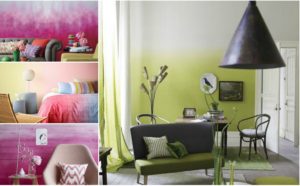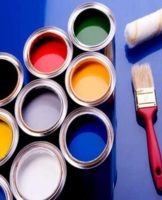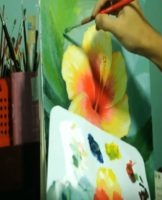The best and how to paint a wooden table with your own hands, technology
Over time, the factory coating loses its original shine, cracks and wears. To restore the look of the table, you can use paints that allow you to give an original look. However, due to the fact that such furniture is constantly exposed to external influences, a number of nuances should be taken into account when choosing a material. Also, before painting a wooden table, you should pay attention to the type of coating.
Advantages and disadvantages of painting a wooden table
Among the advantages of painting a wooden table are the following:
- the appearance is improved;
- mold and mildew protection is provided;
- you can organically fit furniture into the interior;
- minor defects are eliminated.
By painting with special compounds, you can give the table an antique look or decorate furniture.
The disadvantages of this procedure are:
- some types of tables need to be prepared long before painting (remove previous coating, grind, etc.);
- some wood paints are not suitable for tables set up in the kitchen;
- when choosing a dye, it is necessary to take into account the peculiarities of the operation of furniture.
Despite the indicated disadvantages, over time one cannot do without painting the table. This procedure helps to extend the life of the furniture.
Which paint to choose for surface renewal
The kitchen and the other tables are exposed to mechanical stress. In this regard, the coating must be durable. In addition, it is optimal that the paint forms a moisture-resistant layer after drying. These requirements are met by 4 types of similar materials, which also differ in affordability.

Water dispersing acrylic
Water-dispersive dyes are distinguished by the following characteristics:
- nontoxic;
- easy to use;
- lie evenly on the surface;
- wide palette of shades;
- a coating is formed which is resistant to water and ultraviolet radiation.
The advantages of such formulations include the fact that the coating after application can be washed off with clean water. Thanks to this, it is possible to immediately eliminate the defects revealed after painting.
However, the acrylic coating should not be washed with harsh chemicals. In addition, such a material does not tolerate mechanical stress.

Alkyd enamel
Alkyd enamels are used to paint furniture used outdoors. This is explained by the following features of the composition:
- resistance to temperature fluctuations, ultraviolet and humidity;
- the ability to form a glossy or matte finish;
- wide color palette;
- resistance to aggressive chemicals.
Alkyd enamels are available as aerosols or liquid stains. In addition, this product contains toxic substances that have a pungent odor, therefore, when working with alkyd enamel, it is necessary to provide ventilation and wear a respirator.

Nitroenamel
Nitro-enamel paints are popular for two reasons:
- affordable price;
- dry quickly.
Such dyes are in less demand than water-dispersion or alkyd dyes, because the material:
- toxic;
- does not tolerate thermal effects;
- cracks from constant contact with ultraviolet light.
In this regard, it is recommended to use nitro-enamel materials for painting tables that are constantly in the shade.

Oil
Oil stains are rarely used on tables. This is explained by the peculiarities of the composition of paint materials, based on drying oil. This material dries for a long time and forms a thin film on the surface. Because of this, the coating quickly cracks and peels off.
How to prepare a surface for painting
Before repainting the board, it is necessary to prepare the countertop for applying the chosen composition. To do this, you must do the following:
- Dismantle the table. This must be done when all the details are painted. If only the workbench needs to be restored, this step can be skipped.
- Remove the old coating with sandpaper or a grinder. At this stage, the surface is leveled, which has a positive effect on paint adhesion.
- Apply a primer. It is recommended to select the material in the color of the paint.
- Apply putty to the identified defects and retreat with sandpaper or a grinder.

It is also recommended to treat the working surface with an antiseptic, which will create additional protection against mold.At the end of the preparatory stage, the places that will not be painted should be sealed with adhesive tape. At the end of the procedure, it is necessary to wipe the surface with a dry cloth, removing the remaining dirt.
DIY painting technology step by step
Despite the apparent simplicity of application, when painting the table, the following recommendations should be observed:
- The spray can should be shaken for 10-20 seconds to mix all the components together. In this case, the dye should be applied by holding the container at a distance of 20 centimeters from the surface.
- The paint should be poured into a special tray.
- When processing the table, the paint should be applied evenly, in a thin layer.
- The second coat can be applied after the first is completely dry. Thanks to this, it is possible to avoid burrs and other defects.
- Staining should start with the table top, then move to the legs. Furniture fittings are finished at the end.
- The paint should be applied in 2-3 layers.
- To restore the texture of the wood after painting, the surface after the coating has dried must be sanded.
- After drying, a transparent varnish should be applied to the paint.

Subtleties and difficult times
Difficulties in painting the table are largely due to the fact that such home furniture is made from different materials, each of which has its own requirements for the composition of the finish.
Color selection
Choosing the right color is often tricky.
There are two reasons for this. After the coating has dried, the table should be in harmony with the rest of the interior. In this case, after processing the wood, the shade of the surface may change.
To avoid the latter problem, it is recommended to apply the paint in several layers, thereby making the color more saturated. The selected paint material should match the shade of the rest of the furniture in the room or differ by 1-2 tones. You can also use classic colors to paint the pictures: black and white. These shades go well with interiors of different style and design.

Stain your legs
As noted above, before painting the product, the legs should be disconnected from the table top.The procedure in this case should be carried out using a brush. The legs can be painted in the color of the top or in a different shade. The latter option allows you to make the furniture more attractive.
If the legs are made of metal, the surface must be treated with sandpaper to remove the layer of rust and with a solvent to remove grease deposits before painting. In this case, it is recommended to use paint materials with anti-corrosion properties. If the legs are aluminum, the surface must be primed. Otherwise, the paint will peel off quickly.

Work with polished or laminated surfaces
The difficulty of painting laminated surfaces is that special paint strippers or a building hair dryer are used to remove the old coating. After that you can start applying the paint.
Another staining method is also used. In this case, the surface is treated with sandpaper, which roughens the old coating. Then a new paint is applied.
Decoration Options
Painting allows you to create original designs on the table that will make this piece of furniture stand out from the rest of the decor.

Tulle
The use of tulle makes it possible to apply an original pattern to the surface of the table.In this case, it is recommended to use a paint that contrasts with the base color. To create such an image, you will need:
- Lay the tulle on top of the table, securing it tightly around the edges.
- Spray the tulle with spray paint.
- Once the dye is completely dry, remove the tulle.
At the end of the work, it is recommended to apply acrylic varnish to the worktop, which will secure the drawing.

Cutting
Decoupage is a technique for decorating furniture with various patterns. To do this you will need:
- white acrylic paint to create a base;
- aqualak;
- stencils for drawing;
- Sandpaper;
- alcohol;
- primer;
- decoupage glue or PVA.

In this case, the drawing on the table is applied as follows:
- The tray is treated with sandpaper and alcohol. After drying, a primer is applied to the surface.
- The image on thick decoupage paper is processed with sandpaper. The stencil is then soaked in water.
- The stencil is dabbed on both sides with a dry cloth.
- Glue is applied to the table, after which a stencil is applied.
- The remnants of glue are removed with a sponge or cloth.
- After drying, a fixing varnish is applied to the table in 2 layers.
If the drawing is applied to certain areas of the countertop, then before starting the procedure, the surface must be treated with white acrylic.

Rules for maintaining a painted table
Whether the kitchen or office has been painted, the following recommendations will help increase the life of the furniture:
- lacquered or polished worktops can be treated with microfiber towels;
- the varnished surface must be cleaned with a dry cloth;
- unvarnished worktops must be washed so that no water remains on the surface.
Wipe the worktop after each cleaning.



